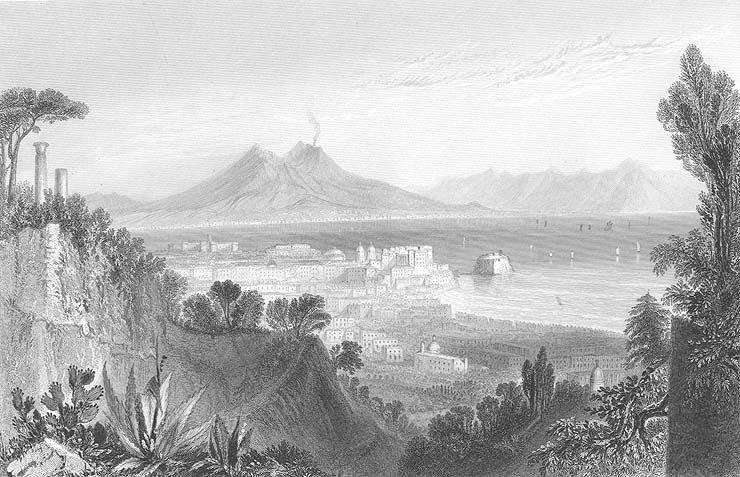
FROM THE ORIGINAL DESCRIPTION: "Illo Virgilium me tettipore dulcis alebat Parllienope studiia florentem ignobilis oti." VIRGIL. The capital of the kingdom of the Two Sicilies presents the loveliest, if not the grandest, prospect on the shores of the Mediterranean. Vesuvius, with its burning cone; is a mighty feature, overlooking and menacing the view and the graceful isleta of Capri and Ischia, with their two semicircular hays, form a composition which has beer uniformly acknowledged as the finest of all the accessible prospects within the European traveller's reach. A gently declining promontory issues from St. El o's Mount, and subsides towards the Castel dell Uovo with an easy curve. The eastern bay does not approach so near to the hills as that of Chiaia, but leaves a capacious vale for the cit) and suburbs, which extend with irregularity over several hills, up into numerous narrow dales, and sink into the arms of Pausilippo. It is probable that luxury and ease here fixed their abode at an early age, for antiquity gives it the title of Ofiosa: modern Sicilians, notwithstanding that history records upwards of fifty insurrections by the Neapolitans, call it Fidelissima. Thus splendidly situated on the margin of a majestic bay, Naples seems to revel in all the blessings which heaven has poured upon this beauteous land; art has combined to embellish the scene, and all that humanity cau desire on earth is to be obtained within this luxurious metropolis. The ancients appreciated the enchantments of this terrestrial paradise, and fable tells of a temple and tomb of the syren Parthenope; bat the story only records the charms of this El-dorado, The Neapolitan is still inordinately Vain of the lasting beauty of his city, calls it a piece of heaven fallen upon the earth, and exclaims, " VediNapoli e poi muori." The air here is mild, balmy, and salubrious: the heat of summer, except during the sirocco, is tempered by the cooling influence of the sea, whose azure mirror attracts and delights the eye, while its deep bosom affords a rich supply of the best fish, the principal food of the inhabitants. Four hundred thousand people throng the public ways, in which the murmur ceases not by night or day; the Toledo, or chief street, resembles a perpetual fair, in which the passenger must be cautious to avoid being run over by the curricoli, which dart past him with the rapidity of lightning. The harbour is always crowded with whipping from all parts of the globe, and the Mole thronged by men engaged in' the business of the port, or idly assembled around the booth of a punchinello or att improvisatore. At evening the fashionable world promenade the streets of Sta. Lucia and Chiaja, which extend along the sea, and form a beautiful Marina: the latter is adorned with stately palaces, amongst which is the Villa Reale, a royal garden, containing the celebrated group with the Farnese bull. Pleasure, not serious business, is pursued at Naples, and amusement is the universal aim. For the idle populace there are punchinellos, music, oranges, macaroni, and room to sleep. For the better classes, theatres, concerts, balls: the nobles are opulent, and fond of parade; the citizens, thriving; the lazzaroni, so temperate, that, from the cheapness of provisions, they can live with the least pittance got by labour or begging, and reserve something for the divertimenti on the Mole; and should other shelter be wanting, they are content with the pronaos of a temple, or the portico of a church. There is much that is artificial and deceptive in the mirth of the Neapolitans, and their incessant activity occupies attention, and diverts from the recollection of other scenes : but the reflecting traveller, after having contemplated Rome and Florence, the wonders of art, and the monuments of the proud days that are gone-great even in their ruins-finds in Naples little to gratify, and much to offend Ins taste. The luxuriance of nature seems to have been communicated to the style of art, and gives it a character of exaggeration. A modern tourist, who devoted many years of his life to the study of the glorious memorials of ancient art preserved in Italy, and to whom the best towns of the continent were familiar, thus concludes his journal: " Were I to choose a fixed abode, it would assuredly not be Naples. There is little neatness in the streets, and an eternal din reigns throughout : bustle and confusion for ever surround one. I like more, for myself, the retirement of a Spanish town, than the gaiety of an Italian one: for a man of pleasure, who is rich, there is but one abode in Italy, and that is Naples. You may study and economize at Milan, Florence, and Rome, but those who travel purely for amusement will spend their money at Naples."
Please note: the terms used in our auctions for engraving, etching, aquatint, lithograph, plate, photogravure etc. are ALL prints on paper, and NOT blocks of steel or wood or any other material. "ENGRAVINGS", the term commonly used for these paper prints, were the most common method in the 1700s and 1800s for illustrating old books, and these paper prints or "engravings" were created by the intaglio process of etching the negative of the image into a block of steel, copper, wood etc, and then when inked and pressed onto paper, a print image was created. These prints or engravings were usually inserted into books, although many were also printed and issued as loose stand alone lithographs. They often had a tissue guard or onion skin frontis to protect them from transferring their ink to the opposite page and were usually on much thicker quality woven rag stock paper than the regular prints. So this auction is for an antique paper print(s), probably from an old book, of very high quality and usually on very thick rag stock paper.
|